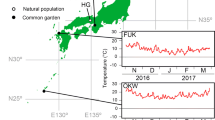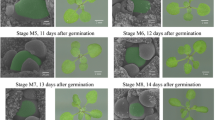Abstract—We have analyzed the gene expression dynamics in floral transition in the CDC Frontier chickpea cultivar. We provide a model, in several versions, to predict the expression dynamics of five flowering genes, taking the expression of their regulators as an input. The models were trained using the random forest method on the previously published expression data for ten flowering genes under the short- and long-day growing conditions. The resulting models correctly predict the dynamics of the average expression levels under long days. We show that the models for CDC Frontier mainly reproduce the regulatory interactions between the key genes described for the Arabidopsis thaliana model plant. Based on the analysis, we hypothesize that the short-day data and the long-day data contain qualitatively different information, which may be due to different regulatory modules that function in different conditions. For the regulators of the flower meristem identity genes AP1 and LFY, our models predict FTa3 as the main activator and TFL1c as the main repressor under long days.







Similar content being viewed by others
REFERENCES
S. Jung and A. E. Muller, Trends Plant Sci. 14, 563 (2009). https://doi.org/10.1016/j.tplants.2009.07.005
A. Kanth and M. Schmid, Cell Mol. Life Sci. 68, 2013 (2011). https://doi.org/10.1007/s00018-011-0673-y
M. Khan, X Ai, and J. Zhang, Wiley Interdisc. Rev. RNA 5, 347 (2014). https://doi.org/10.1002/wma.l215
J. A. Banta, I. M. Ehrenreich, S. Gerard, et al., Ecol. Lett. 15, 769 (2012). https://doi.org/10.1111/j.1461-0248.2012.01796.x
F. Andres and G. Coupland, Nat. Rev. Genet. 13, 627 (2012). https://doi.org/10.1038/nrg3291
V. Hecht, F. Foucher, C. Ferrandiz, et al., Plant Physiol. 137, 1420 (2005). https://doi.org/10.1104/pp.104.057018
R. Benlloch, A. Berbel, L. Ali, et al., Front. Plant Sci. 6, 543 (2015). https://doi.org/10.3389/fpls.2015.00543
J. L. Weller and R. Ortega, Front. Plant Sci. 6, 207 (2015). https://doi.org/10.3389/fpls.2015.00207
C.-H. Jung, S. E. Wong, M. B. Singh, and P. L. Bhalla, PloS One 7, e38250 (2012). https://doi.org/10.1371/journal.pone.0038250
H. D. Upadhyaya, D. Bajaj, S. Das, et al., Plant Mol. Biol. 89, 403 (2015). https://doi.org/10.1007/sl1103-015-0377-z
J. L. Weller and R. C. Macknight, Methods Mol. Biol. 1822, 261 (2018). https://doi.org/10.1007/978-1-4939-8633-0_17
R. Ortega, V. F. Hecht, J. S. Freeman, et al., Front. Plant Sci. 10, 824 (2019). https://doi.org/10.3389/fpls.2019.00824
M. Blumel, N. Dally, and C. Jung, Curr. Opin. Biotech. 32, 121 (2015). https://doi.org/10.1016/j.copbio.2014.11.023
S. Ridge, A. Deokar, R. Lee, et al., Plant Physiol. 175, 802 (2017). https://doi.org/10.1104/pp.l7.00082
K. E. Jaeger, N. Pullen, S. Lamzin, et al., Plant Cell. 25, 820 (2013). https://doi.org/10.1105/tpc.113.109355
F. C. Sussmilch, A. Berbel, V. Hecht, et al., Plant Cell. 27, 1046 (2015). https://doi.org/10.1105/tpc.115.136150
F. Valentim, S. van Mourik, D. Pose, et al., PloS One 10 (2), e0l16973 (2015). https://doi.org/10.1371/journal.pone.0116973
R. K. Varshney, C. Song, R. K. Saxena, et al., Nat. Biotechnol. 31, 240 (2013). https://doi.org/10.1038/nbt.2491
V. V. Gursky, K. N. Kozlov, S. V. Nuzhdin, and M. G. Samsonova, Front. Genet. 9, 547 (2018). https://doi.org/10.3389/fgene.2018.00547
F. Pedregosa, G. Varoquaux, A. Gramfort, et al., J. Machine Learning Res. 12, 2825 (2011).
Funding
This study was supported by the Ministry of Science and Higher Education of the Russian Federation (task no. 1.8697.2017/BCh).
Author information
Authors and Affiliations
Corresponding author
Ethics declarations
The authors declare that they have no conflict of interest. This article does not contain any studies involving animals or human participants performed by any of the authors.
Additional information
Translated by M. Batrukova
Abbreviations: LD, long day; SD, short day; NMSE, normalized mean square error.
Rights and permissions
About this article
Cite this article
Podolny, B.S., Gursky, V.V. & Samsonova, M.G. A Machine-Learning Analysis of Flowering Gene Expression in the CDC Frontier Chickpea Cultivar. BIOPHYSICS 65, 225–236 (2020). https://doi.org/10.1134/S0006350920020189
Received:
Revised:
Accepted:
Published:
Issue Date:
DOI: https://doi.org/10.1134/S0006350920020189




